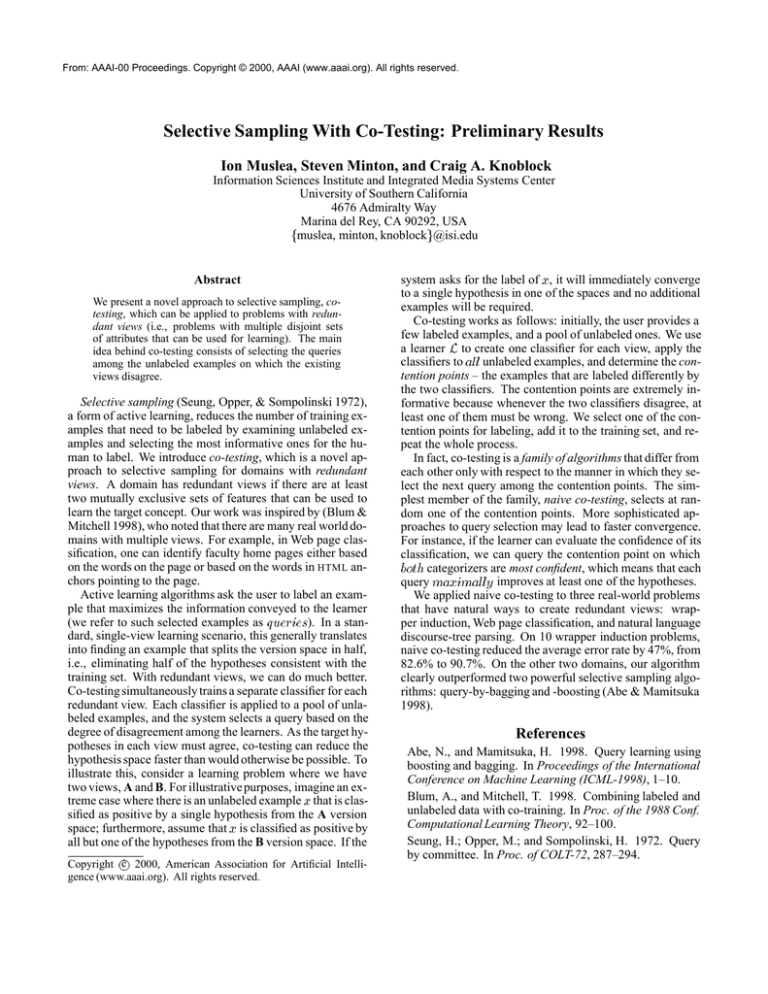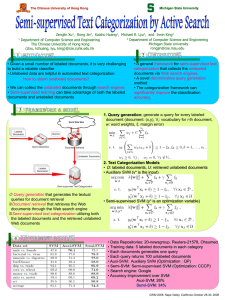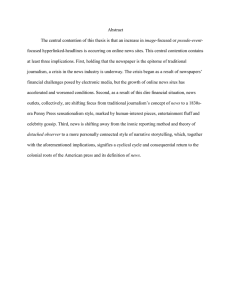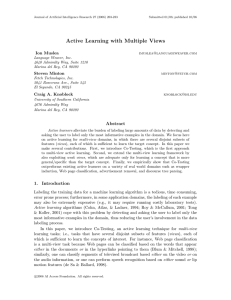
From: AAAI-00 Proceedings. Copyright © 2000, AAAI (www.aaai.org). All rights reserved.
Selective Sampling With Co-Testing: Preliminary Results
Ion Muslea, Steven Minton, and Craig A. Knoblock
Information Sciences Institute and Integrated Media Systems Center
University of Southern California
4676 Admiralty Way
Marina del Rey, CA 90292, USA
muslea, minton, knoblock @isi.edu
Abstract
We present a novel approach to selective sampling, cotesting, which can be applied to problems with redundant views (i.e., problems with multiple disjoint sets
of attributes that can be used for learning). The main
idea behind co-testing consists of selecting the queries
among the unlabeled examples on which the existing
views disagree.
Selective sampling (Seung, Opper, & Sompolinski 1972),
a form of active learning, reduces the number of training examples that need to be labeled by examining unlabeled examples and selecting the most informative ones for the human to label. We introduce co-testing, which is a novel approach to selective sampling for domains with redundant
views. A domain has redundant views if there are at least
two mutually exclusive sets of features that can be used to
learn the target concept. Our work was inspired by (Blum &
Mitchell 1998), who noted that there are many real world domains with multiple views. For example, in Web page classification, one can identify faculty home pages either based
on the words on the page or based on the words in HTML anchors pointing to the page.
Active learning algorithms ask the user to label an example that maximizes the information conveyed to the learner
). In a stan(we refer to such selected examples as
dard, single-view learning scenario, this generally translates
into finding an example that splits the version space in half,
i.e., eliminating half of the hypotheses consistent with the
training set. With redundant views, we can do much better.
Co-testing simultaneously trains a separate classifier for each
redundant view. Each classifier is applied to a pool of unlabeled examples, and the system selects a query based on the
degree of disagreement among the learners. As the target hypotheses in each view must agree, co-testing can reduce the
hypothesis space faster than would otherwise be possible. To
illustrate this, consider a learning problem where we have
two views, A and B. For illustrative purposes, imagine an extreme case where there is an unlabeled example that is classified as positive by a single hypothesis from the A version
space; furthermore, assume that is classified as positive by
all but one of the hypotheses from the B version space. If the
Copyright c 2000, American Association for Artificial Intelligence (www.aaai.org). All rights reserved.
system asks for the label of , it will immediately converge
to a single hypothesis in one of the spaces and no additional
examples will be required.
Co-testing works as follows: initially, the user provides a
few labeled examples, and a pool of unlabeled ones. We use
a learner to create one classifier for each view, apply the
classifiers to
unlabeled examples, and determine the contention points – the examples that are labeled differently by
the two classifiers. The contention points are extremely informative because whenever the two classifiers disagree, at
least one of them must be wrong. We select one of the contention points for labeling, add it to the training set, and repeat the whole process.
In fact, co-testing is a family of algorithms that differ from
each other only with respect to the manner in which they select the next query among the contention points. The simplest member of the family, naive co-testing, selects at random one of the contention points. More sophisticated approaches to query selection may lead to faster convergence.
For instance, if the learner can evaluate the confidence of its
classification, we can query the contention point on which
categorizers are most confident, which means that each
improves at least one of the hypotheses.
query
We applied naive co-testing to three real-world problems
that have natural ways to create redundant views: wrapper induction, Web page classification, and natural language
discourse-tree parsing. On 10 wrapper induction problems,
naive co-testing reduced the average error rate by 47%, from
82.6% to 90.7%. On the other two domains, our algorithm
clearly outperformed two powerful selective sampling algorithms: query-by-bagging and -boosting (Abe & Mamitsuka
1998).
References
Abe, N., and Mamitsuka, H. 1998. Query learning using
boosting and bagging. In Proceedings of the International
Conference on Machine Learning (ICML-1998), 1–10.
Blum, A., and Mitchell, T. 1998. Combining labeled and
unlabeled data with co-training. In Proc. of the 1988 Conf.
Computational Learning Theory, 92–100.
Seung, H.; Opper, M.; and Sompolinski, H. 1972. Query
by committee. In Proc. of COLT-72, 287–294.





